ACKNOWLEDGEMENT
Would like to express my special thanks of gratitude to my teacher Ar Grace Elizabeth Rajan as well asourprincipalAr.DileepKumarsirwhogavemethegolden opportunity to do this wonderful project on the topic Workhomes: A Case Of Balaramapuram, which also helped me in doingalotofResearchandicametoknow about so many About workhomes , traditional trade settlements of trivandrum and understanding the scope of workhomes in regenerating the lost glory of a traditional tradesettlementtosetitforthefuture.
4
ABSTRACT
Work-homes have been used by the people sinceancienttimes buttoday peoplepreferto use work-home ideology because of the epidemic condition, technological advantages, time saving, budget savings etc Advancements in communications have created new ideologies like work from home etc. I believe work-homes are a broader concept than what currently exists The declination of the traditional trades and trade settlement can be connected to the inadequate development of the settlement which cannot meet the requirements of the present keeping the link with the past traditional valuesin this research I deal with understanding the link of workhomes towards the traditional trade settlements and the possibilities of restoring the glory of traditionaltradesettlementsby workhomeideologiesconsideringthetradesettlementofBalaramapuram,Trivandrum.
Keywords: Workhomes,traditionaltradesettlements,revitalization
5
,transforming
CONTENTS DECLARATION i CERTIFICATE ii ACKNOWLEDGEMENT iii ABSTRACT iv CONTENTS v LISTOFTABLES viii LISTOFFIGURES ix LISTOFMAPS xi 1 Introduction 16 1.1 Background 16 1.2 Needofthestudy 16 1.3 Researchquestions 17 1.4 Aim 17 1.5 Objectives 17 1.6 Methodology 18 1.7 Limitations 19 2 UsabilityofWorkhomes 20 2.1 Introduction 20 2.2 Whatisaworkhome? 20 2.3 Evolutionofworkhomesacrosstheworld 20 2.3.1 Timelineofworkhomes 21 2.3.2 Timelineofmobileworkhomes 21 6
2.4 WorkhomesofKerala 22 2.4.1 Typo-morphologicalAnalysisofHouses 22 2.5 .Typologiesofworkhomes 23 2.5.1 Thearchitecturalworkhome 23 2.5.2 Proximity 24 2.5.3 DominantFunction 23 2.6 Relationshipbetweentypologiesofworkhomes 26 2.7 Parametersofworkhome 27 2.8 Workhomesatcommunitylevel 29 2.8.1 Advantagesofworkhomesincommunitylevel 29 2.8.2 Disadvantagesofworkhomesincommunitylevel 29 3 Traditionaltradesettlement 30 3.1 Whatisatraditionaltradesettlement? 30 3.2 Traditionaltradesettlementoftrivandrum 30 3.2.1 AnchuthenguandAnjengoFort 30 3.2.2 Chalaibazaar 31 3.2.3 Balaramapuram(textileindustry) 34 3.3 HandloomIndustryinKerala 35 3.3.1 Weaversatisfactionrates 37 3.3.2 PresentcentersofthehandloomindustryinTrivandrum 38 4 Balaramapuraamtradesettlement 39 4.1.1 Historyofthecluster 39 4.1.2 Structureofthesettlement 40 4.1.3 Presentscenario 42 5 Findings,conclusion,suggestions 43 7
5.1 Findings 43 5.1.1 problemsfacedbythetraditionalhandloomWeavers 44 5.1.2 SocioeconomicconditionsoftheWeavers 45 5.1.3 Reasonsforthedownfall 46 5.2 CONCLUSION 47 BIBLIOGRAPHY 49 8
TABLES Table2-1:Workhomeusergrouptypologies 7 Table3-1 keraladistrictwisedistributionofhandloomworkers 36 Table3-1:keraladistrictwiseweaversatisfactionrate 37 9
LISTOF
LISTOFFIGURES
Figure2-1:Historyofmobilehomesinunitedstates 21 Figure2-2:Livewithintypology 24 Figure2-3:Workhometypologybasedonmovement 24 Figure2-4:Liveneartypology 25 Figure2-5:Livenearbytypology 23 Figure2-6:Typologiesbasedondominantfunctions 23 Figure2-7:Relationshipbetweentypologiesofworkhome 26 Figure2-8:Parametersofworkhomes 27 Figure3-1:Anchuthenguandanjengo 30 Figure3-2:Chalaibazartrivandrum 31 Figure3-3:Settlementinstreetsofchalaibazar 32 Figure3-4:GoldsmithsandgoldworkersinstreetsifChalaibazar 33 Figure3-5:WholesalesandretailshopsinChalaibazar 34 Figure3-6: theheadloadworkersofchalaibazar 34 Figure3-7:handloomworkerofBalaramapuram 35 Figure4-1:roughsketchofweaversstreetofBalaramapuram 40 10
LISTOFMAPS
Map3-1:KeylocationoftheWeavingindustryinKerala 39 Map4-1:structureofBalaramapuramtown 40 Map3-2:PresentcentersofthehandloomindustryinTrivandrum 42 11
CHAPTER1
1 Introduction
1.1 Background
Most of the trade settlements in Kerala are characterized by the work homes .Work-homes have been used by the people since ancient times but, today people prefer to use work-home ideology because of the epidemic condition, technological advantages, time saving, budget savings etc. Advancements in communications have created new ideologies like work from home etc. I believe work-homesareabroaderconceptthanwhatcurrentlyexists.
Usually transformations of traditional settlements are carried out due to socio-economic changes in the settlements being carried out without trying to conserve the heritage of the area hence leading to the loss of the historical background and importance. The transformation should be controlled by using conservation of heritage areas as a tool for the regeneration of the settlement, so thatthesettlementisconservedaswellastheneedsofthepeoplearemet.
Through my research I am trying to understand how modern work home concept can improving the issues faced by the traditional trade settlements in Balaramapuram, Trivandrum by using work home principles, and typologies with a set of design elements, so the people can use that time efficiently without any distractions, providing emotional satisfaction with a space, getting the 'job' done quicklyandefficientlyinthespace.
1.2 Needofthestudy
In the rapidly transforming world the traditional trade settlements tend to face numerous problems which lead to the declination or extinction ofthetradeand/or the settlement leading tothelossoftheculturalandtraditionalidentityofthearea.
12
The study help in adding knowledge in usability ofworkhomesinrevivingofthe traditional trade settlements and later it would be useful in implementing transformationofhistorictradesettlementswithoutlosingitsculturalidentity
1.3 Researchquestions
Canmodernworkhomesbethenextbestsolutionforcreatingworkspacesfor revivingatraditionaltradesettlement?Canmodernworkhomesbethenextbest solutionfortransformingtraditionaltradesettlementforgoodwithoutlosingits culturalandhistoricimportance?
1.4 Aim
To study, Linkage of traditional trade settlements and work homes in Trivandrum ,its transformation from pastto presentand scopeforworkhomes inimproving the workability and economy of the traditional trade settlements in Trivandrum without losing its cultural importance byapplicationofworkhomeprinciples,and typologieswitha set of designelements
1.5 Objectives
• Tounderstandwhataworkhomeisandusabilityacrosstheworld.
• TounderstandwhatisaworkhomeandusabilityacrossKerala
• To understand whatisatraditionaltradesettlementandidentifythetraditionaltrade settlementsofTrivandrum
• To understand the linkage between the traditional trade settlementandworkhomes ofTrivandrum
• Tounderstandtraditional trade settlement of Balaramapuram
• To understand the cause for the diminishing of identified traditional trade settlementsofBalaramapuram
• To identify how themodernworkhomesconceptcanbethesolutioninrevivingthe Balarampuram traditional trade settlements without losing its cultural and historic importance by possible typologies of work homes and incorporating key interior
13
elementsinaccordancetotheidentifieduserrequirements.







1.6 Methodology


1.7 Limitations
Onetradesettlementisonlyselectedforthedetailedstudyduetothetimelimit.





14
CHAPTER2
2 UsabilityofWorkhomes
2.1 Introduction
In this chapter the concept of work homes and its usability across the world and Kerala is understood through the literature. The typologies and the parameters neededforaworkhomeisunderstood.
2.2 Whatisaworkhome?
Work home is a placewherepeoplebothliveandaregivenajob.Peoplehavelived at their workplaces or worked at homeforhundredsifnotthousandsofyears,often in buildings specifically designed for the dual uses of dwelling and workplace.We callthesebuildings'workhomes'
A mobile home is generally defined as "a factory-made structure, with a chassis attached to it, this can either be transported to site (either by being towed or on a trailer) or It can also be a vehicular home where one can live/work and travel init. These typologies can be used for many purposes like - permanent homes, or a holiday or temporary accommodationoraworkspace.Thesemobilelivingunitsare placed in a space permanently or semi permanently but can always be moved whenevertheuserwantsto.
2.3 Evolutionofworkhomesacrosstheworld
From old times the building type that combined dwelling and workplace, often designed specifically to accommodate the dual function was called 'house', with subsets of 'bakehouse', 'bath-house', 'weaver's house', 'ale house' etc. But in the twentieth century, the term 'house' came to mean a building in which wecook,eat, bathe, sleep, watch TV and bring up our children, nothing more. And so the dual-usebuildingtypethatcombinesdwellingandworkplacelostitsname.
15
2.3.1 Timeline of work homes
2.3.1.1 Midfourteenthcentury
● England
Includes three typical work homes: the longhouse, the merchant's house and the manor house
● Japan
Threebuildingtypes,mirroringthepower-relationswithinsocietydominated 'buke-yashike ' or 'spread-out houses' of the ruling classes and warriors,'machiya' where shopkeepers and merchants lived and worked, 'nagaya' work homes of artisans and craftsmen.
2.3.1.2 Otherregions
● Malaysian shop-House
● Iraniancourtyardhouse
● Vietnamesetubehouse
● Lyons silk-weaver'satelier
● Dutchmerchant'shouse.
2.3.1.3 1601-Workhouse
● Institution to provide employment for paupers and sustenance for the infirm, found in England from the 17th through the 19th century and also in such countries as the NetherlandsandincolonialAmerica.
● A public institution in which the destitute of a parish received board and lodginginreturn forwork
2.3.1.4 Beforeindustrialrevolution
Workinginthehomeorlivingattheworkplacewasthenorm,buildingsthatcombinedwellingand workplacewereinalmostuniversaluseandsettlementswerelargelyselfserving
16
2.3.1.5 Publications1960-2002
However, despite their general absence in architectural histories, a large amount of historical evidence of these buildings can be found, fragmented in form. Some publications focus on the occupation of the inhabitant, such as the 'Medieval Merchant's House' (Coppack, 1991), or the 'Artist's Studio House' (Walkley, 1994). Others in particular periods, such as the 'Industrial Revolution in Coventry' (Prest, 1960). Many buildings can be found in the oeuvre of individual architects, such as 'Tadao Ando (Ando and Dal Co, 1995) or 'Frank Lloyd Wright' (Larkin and Pfeiffer, 1993). A few books compile contemporary 'live /work' buildings (Cerver, 1999, Cuito, 2000, Field and Irving, 1999), and articles describe individual projects (Kerr, 2001, Kolleeny and others, 2002, Pearson, 1992). In general these publications lack analysis and treat the hybrid buildingstheydescribeeitheras'one-offs'orashousesdominates'
2.3.1.6 1970
The term 'live/work' was coined and generated as part of ahighlysuccessfulbrandingexercisefor loftdevelopmentsinSoHo,NewYork.
2.3.1.7 Nineteenth-century:studio-house
The studio-houseisacommonnineteenth-centuryworkhomewithalonganddistinguishedroom foralltheactivitieswithzonedspacesaccordingly
2.3.1.8 2006
Dolan defines a 'live/work' unit as a space in which the quiet enjoyment expectations of the neighbors in the building oradjacentbuildingstakeprecedenceovertheworkneedsoftheunitin question. Therefore, the predominant use of a Live/work units are residential, and commercial activityisasecondaryuse;employeesandwalk-intradearenotusuallypermitted.
2.3.1.9 2007
Frances Holliss coined the term "work home" to describe all buildings that combine dwelling and workplace. At the larger scale she referred to developments of these dual-use buildings as work homebuildingsorworkhomedevelopments.
17
2.3.2 Timeline of mobile work homes
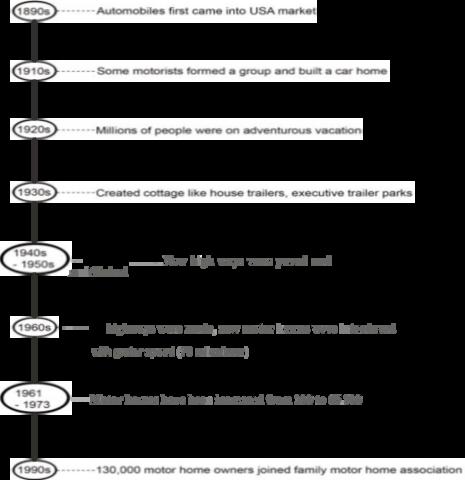
2.4 WorkhomesofKerala
Kerala is a state in South India popularly known as Malabar The people of Kerala are called Malayali and they speak a local language, Malayalam. The environment of Kerala shares characteristics with the mainland of Southeast Asia and the Pacific archipelago, such as tropical climate,anaveragetemperatureof250C-280Candfrequentrainfall.
The indigenous land of Kerala constitutes a span offertilemidlandbetweenthemountainsandthe sea which is blessed with high rainfall and rich biodiversity conducive to a wet agriculture living
Figure2-1:historyofmobileworkhomesinUnitedStates
18
culture. The nature of the midland economy favours the emergence of isolated communities,each limited to a minor watershed defined by the buttresses of the ghats and small rivers. Paddy cultivationwaslargelyundertakenalongsidetheriverbanks
The formulations of settlements in Kerala wereanevolutionofclan-habitations.Thestructurewas unlike the classical composition of any Indian village which was based oncastegroupings,butby natural enclaves inhabited by one or more communities and later professional distinctions formed ineachenclave(KeralaKhrisnaIyer,1968).
People in Malabar are institutionalized in a corporate body of a unilineal descent group,whichis called veedu or taravad. Each social unit of the joint-family turned into aprincipalitythatresulted in a feudal organization. The head of taravad or veedu is called karanavar and they are usually selected from the eldestmalememberofthejoint-family Theyareinchargeofthemanagementof the clan and their enterprise. Economically, each taravad represents one corporate-kin body of an agriculture estate where land-tenure was the basic management of natural resources. It makes the organizationoftaravadtheunitofindigenouslivingcultureofKerala.
2.4.1 Typo-morphological Analysis of Houses
Typo-morphological mapping of Kerala houses suggest that a single-rectangular hall furnished with a veranda is the basic spatial unit for dwelling. The row of rooms with common spaceatthe front is the basic spatial concept for interior This hall structure is characterizedbyasolidannular wall plate (uttaram) on which the roof structure rests. The veranda was originally the extended overhanging of eaves (alindam) that protected the building from rain and the sun’s glare that provided a sitting area attached to the house. This type constitutes a generic spatial-structure of housesinKerala(veedu),whichiscalledekasala.
In the agriculturist families, the row of rooms (kalavaras) constitutes a core with themiddleroom as ara. Other than ara, kitchen (aduppu) and well (kinar) is the most important room in the house and the nalukettu, comparable to the sacred courtyard. It could be located in one of the rooms or putinaseparatedhallattachedtothemainhall.
The humblest vernacular construction is made of weaved bamboo, thatched roof and wattle and daub construction. Originally, Kerala's roof structure was covered by thatch until it wasbannedin 1759ADandalteredtowardtheusageofMangaloretilesbyroyalcommand.
The oldest residential nalukettu (400-years old) found in Aranmula and arapura in Kanyakumari district show a nalukettu made fully of a timber structure and a wooden panelling system (nira), 19
without wall fenestrations. Provision of mukhapu (gable board) on both ends of ridges and small courtyard is another outlet forsunlightandventilation.Intheadvancedbuildings,asrecentas80–150 years old, the buildings were of bigger scale and built from more massive materials such as laterite. Massive building constructions and use of laterite are found more frequently towards the northern part of Kerala. The houses for working class people in olden times the occupation was assigned based on caste and their dwelling and nearby regions constitute the workingspaceofthe trade.
2.5 Typologiesofworkhomes
2.5.1
The architectural work home
As with the vernacular buildings, two contrasting approaches emerge: one involves spaces carefully designed around a building’s dual functions; the other involves the design of flexible spacesthatcanaccommodateanyfunction.
The typologies of work homes are classified based on building functions ordistances from differentactivitiesetc.Theseareagaincategorizedinvarioustypesbasedon
1.Proximity
2.Dominant
Function
3.Patternsinuse
2.5.2
Proximity
Proximity is based on the distance between the Work space andthedwellings.Inthistypologywe see how workspace and residence are physically arranged to each other.There are 3 types of proximities:
1.Live-within2.Live-near3.live-nearby
2.5.2.1
Live-within
Live-within is the most common typology, but not necessarily the most popular or desirable arrangement. A live-within unit is entirely contained within the confines of one room or "common atmosphere", there is no permanent physical separation in between personal and professionalspaces.Generally,theseunitsconsistofakitchen/diningarea,bathroom,sleeping spaceandacontiguousspacewithasingleentrance.
20
This typology isgenerally usedby artists. Flexibility with partition walls or movable walls amount of space assigned to the living or the work is uncertain; it always varies due to the activity of the person in that space. In this typology thefloorheightisgenerallyhigh due to which the resident will have the flexibility to add a mezzanine floor. In this typology the primary delineator of space in not in the walls but in the variations in the roofheights
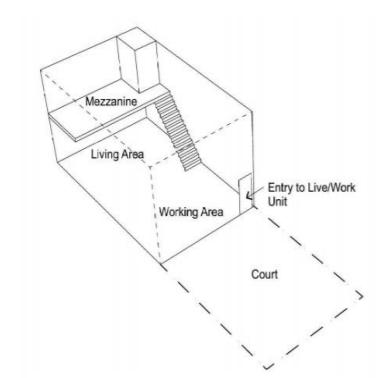
Thesearefurtherclassifiedbasedonmovementintotwo:
There are no specific typologies in these categories, people either live in a motor vehicle or in a boat.
These work homes are placed in a certain place and there is no movement.it can be of live/work, work/live,dualuse
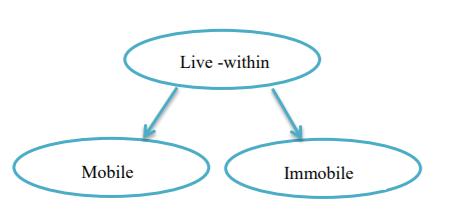 Figure2-2:livewithintypology
Figure2-3:workhometypologybasedonmovement
2.5.2.2 Mobileworkhomes
2.5.2.3 Immobileworkhomes
Figure2-2:livewithintypology
Figure2-3:workhometypologybasedonmovement
2.5.2.2 Mobileworkhomes
2.5.2.3 Immobileworkhomes
22
2.5.2.4 Live-near
In this topology there is some spatial separation between living and working spaces while still meeting the needs. Having a workspace in a different room from thelivingspaceisalsoaformof live-near
The flexibility in this type allowstheownertoseparatethelivepartoftheunitfromtheworkpart. In this typology the two functions are contained in separatecompartmentsnextdoortoeachother, above or below, or side by side each with its own entrance to the street, but theyhavetobeinthe samebuilding.

In this typology thespatialseparationbetweenworkandhomecanbebyaphysicalwalloraslab. Even though both the typologies share the same entrance or not, there is often an internal linking doorway, which allows movement between the two worlds(someprefernottohavethelink).This typology helps the resident toworkcontinuouslywithoutanydisturbancebyfamilyorroommates. Acousticsplayanimportantroleinthistypology.
Live in typology provides flexibility to the owner; he can use both the spaces or rent one of them or both of them separately This typology is useful where the two functionshaveconflicting designconstraints.
23
Figure2-4:live-neartypology
2.5.2.5 Live-nearby
In this typology the living and the workingspacesareseparated by a short walk. The separation can be done by courtyard, garden etc. Walking distance is generally from 2 -5 min. In this typology both the work and the dwelling does not have to be on the same property or within the same plot, it can be different. The workspace feels totally disconnected from living.
In some cases, home and work are separated and are linked by gardens. There will be different entrances for both home and work. Acoustics don't play much role in this space because the buildings are not physically connected. This typology generally exists in the outskirts of the cityor intowns.
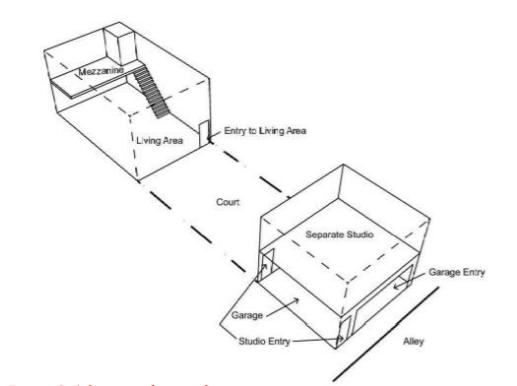
2.5.3 Dominant Function
Dominant function is based on the work-use intensity factor that is dominated by work activity versusfamilyactivities.Thedominantfunctionisdividedintothreetypologiesavailabletheyare
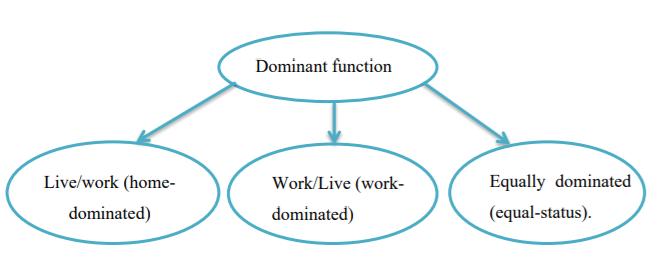 Figure2-5:live-nearbytypology
Figure2-5:live-nearbytypology
24
Figure2-6:Typologiesbasedondominantfunction
One important note to be made is that live-in or live-near can come into these typologies but not live-nearby.
2.5.3.1 Live/work
The major usage of a typical live/work unit is residential activities and the work activity is secondary In this typology employees and walk-in trade may be permitted, in which case accessibility measures are required in the work portion if public accommodation exists. In many cases, client visits are by appointment only, and employees are sometimes permitted but typically limited in number Acoustics play a vital role in separating the noise from both the activities. Flexibilityiskeyinlive/work.
More than either home occupation or work/live, it is assumed that the dominance of work versus residence in a live/work unit will ebb and flow over time. For that reason, a live/work unit best embodiesmixedusewithintheunit(orproperty)itself.
Flexibility can also be achieved by using movable walls or partition walls etc. For instance, a movable partition allows the artist to vary the size of her work space to suit her needs at anygiven time. Due to the lower-intensity of work activities likely to occur there, (compared to living) a separation isunlikelytoberequiredbetweentheworkspaceandtheresidence.Ifthereisnopartition theworkspacecanbeusedasadwellingoncetheworkisdone.
This provides the live-workingeneraltoadapteasilytosuchinevitablechange.Live/workunitscan be of any spatial configuration, and their work spaces might be anywhere: in the unit, in the building,oronthesameproperty.
A live/work unit is likely to be located anywhere in the middle range of urban intensity, meaning anywhere except the lowest-density residential areas and moderate- to high intensity industrial district. Live/work buildings tend to take theformofaflexhouse,abuildingwithacourtyard,oran urbanloftproject.
Renovated live/work tends to occur in former warehouses, factories, and commercial buildings, often located in commercial districts. Home dominated work-homes generallyincludeflats,houses, cottages,abungalowandalive/workunit.
25
2.5.3.2 Work/live
Work/live isatermwhichisgenerallyusedtodescribeawork-homeunitinwhichtheuserneedsof the work component are preferred when compared to the dwellings. These spaces are generally affectedbynoise,odours,employees,walk-intrade,orsales.
Acoustics play a vital role in design. Generally, in this typology the primary use of the work/live homes is 20 commercial or industrial activities whereas the residential issecondary.Theresidential portion in this typology is generally less when compared to a work space. The work space in the work/live units are generallyinthemainorgroundfloor,anditisoftenseparatedfromtheresidence by a wall or floor or ceiling (in this case this typology is similar to the live-near typology). It may alsooccurinaseparatespace.
A common type of work/homesistheflexhouse,anancienturbanbuildingthataccommodatesboth the activities. Work/live homes are generally located in commercial, mixed-use, industrial areas. Work dominated work-homes generally include industrial units, funeral parlour, historic house, residentialcare-home.
2.5.3.3 Equallydominated
In this typology both the living and the work are equally dominated. In this typology both the activities have separate spaces within the same unit. They can have the option ofhavingasingleor separateentrancebasedontheactivities.
Patterns in use In this typologyIrrespectiveoftheinhabitbuildingsdifferentpeopleusethespacein differentways(sometimesirrespectiveoftheirdesign).Thedifferenttypologiesinthiscategoryare
1.Dual-usespace
2.Dedicatedlivingspace
3.dedicatedworkspace.
These are determined based on the personality, the work they do, and the people with whom they live. This pattern of use aligns more closely with the spatial design strategy employed in their work-homes. In all these typologies that we discussed above, building materials always playavital roleindifferentiatingthespace.Materialsusedflagupthehybrididentityofthebuilding.
26
2.6 Relationshipbetweentypologiesofworkhomes
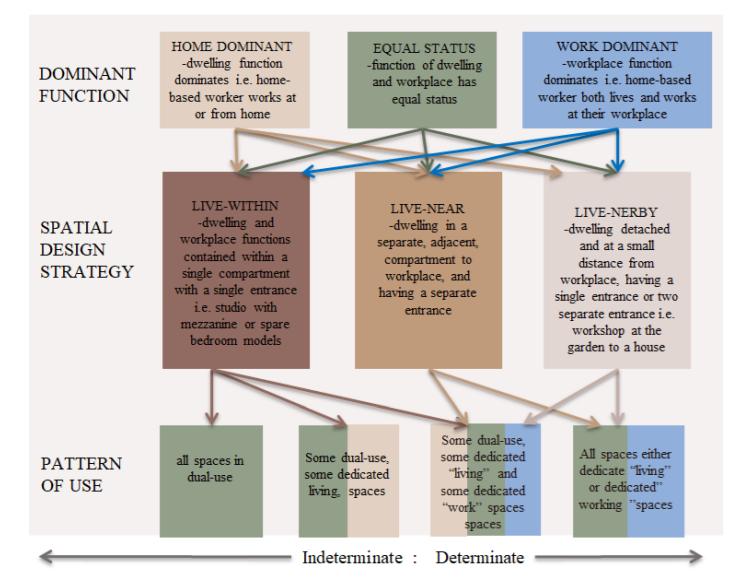
2.7 Parametersofworkhome
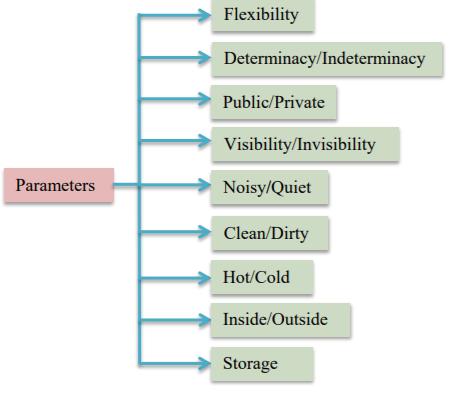 Figure2-7:Relationshipbetweentypologiesofworkhomes
Figure2-7:Relationshipbetweentypologiesofworkhomes
27
2-8:parametersofworkhomes
Work-homes serve as residence/work spaces for various professional groups. Irrespective of their usageorthetypologiesinit,therearecoupleofdesignparameterswhicharecommonlyconsidered
 Figure
Figure
28
Table2-1:Work-homeusergrouptypologies
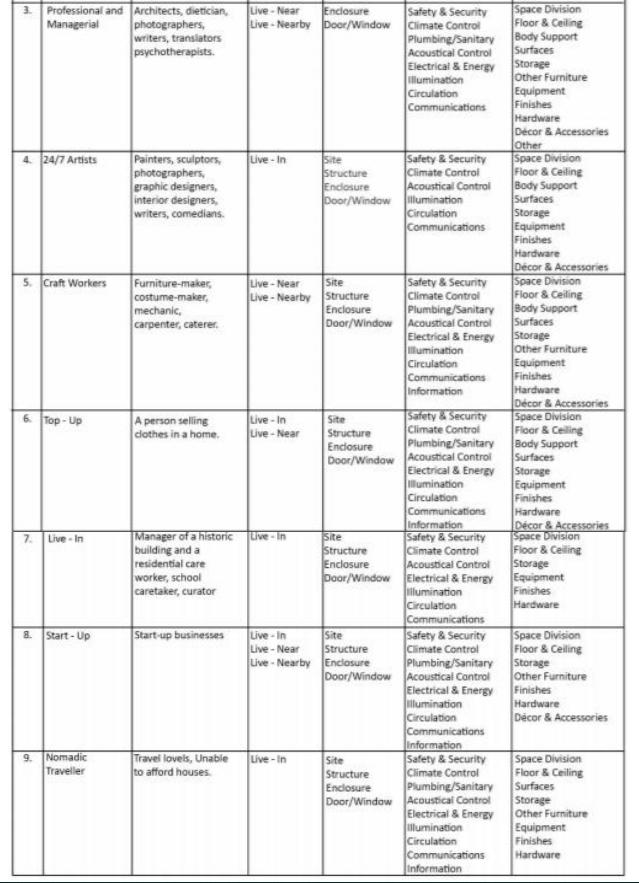
29
Table2-1:continued
2.8 Workhomesatcommunitylevel
2.8.1 Advantages of work homes in community level
Acceptance of mixed use as an ordinary condition of life is an integral part of live-work. It makes more sense if work-homes exist inmixed-useneighbourhoods.Asetofworkhousesinacommunity can create a potential level for interactions which can provide a sense of security. The benefits of havingwork-homesincommunitylevelare
• Createcontactswithintheneighbourhood.
• Improvessocialcapital.
• Createsasenseofsecurityintheneighbourhood
People who live in the neighbourhood can gather and start a small-scale industry from home. This stimulates the local economy.Homebasedworkalsoincreasesmixedeconomy,alltheemployeesin one area can work together, thereby creating income to one another .One can achieve identity, recognition and respect for the home-based work as his work can help the community thereby producingincomeforhim(mutual-interest).
2.8.2 Disadvantages of work homes in community level
Work-homes willalsochangetheplanningofthecity.Consideringawork-homeinaneighbourhood setting, when people move from one home to another sometimes they lead to Impromptu interactions. Categorizing work-homes in zoning maps is an issue for these because it shares both charactersofresidenceandcommercial.
30
CHAPTER3
3 Traditionaltradesettlement
In this chapter the concept of traditional trade settlements is studied to identify traditional trade settlements of Trivandrum and understating the brief structure of handloom industryofTrivandrum tounderstandbetteraboutBalaramapuramtradesettlement.
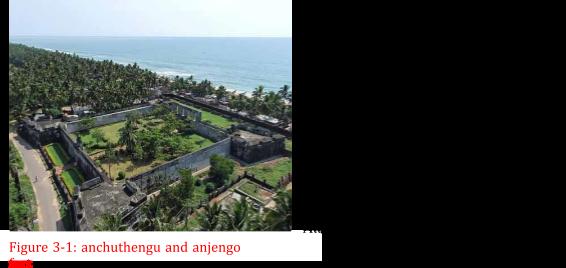
3.1 Whatisatraditionaltradesettlement?
Traditional trades (known also as traditional building trades and preservation trades) is a loosely defined categorization of building trades who actively practice their craft in respect of historic preservation, heritage conservation, or the conserving and maintenance of the existing built environment. Though traditional trade practitioners may at times be involved in new construction, the emphasis of the categorization is toward work on existing structures, regardless of their age or their historic value, with a specific interest in replication or conservation of the original results and crafttechniques.Thesettlementsformedbythesettlingoftradersorworkersofaspecifictradeinan area in past are termed as traditional trade settlements. Each traditional trade settlement will be knownforitsspecifictrade.
3.2 Traditionaltradesettlementoftrivandrum
3.2.1 Anchuthengu and Anjengo Fort
31
Attingalandthatishowthefortgotitsname.Thefortservedasthefirstsignallingstationforships arriving from Britain. The construction of the fort commenced in 1696, and was completed in 1699. While construction was ongoing the Dutch lobbied the Rani against the fort's construction, as it would impact adversely on their trade on the Malabar coast. She ordered Brabourne to stop building but he ignored her orders. The Rani then tried to starve out the British by cutting off supplies; butastheycouldbesuppliedfromthesea,thelandblockadeprovedineffectual.Shethen sent an armed force against Brabourne but he defeated it and peace wasarranged.Thefortplayed an important role in the Anglo-Mysore Wars. In 1721, the fort became a key site of the Attingal Rebellion against the British. During the Anglo-Mysore wars the Britishstoredammunitionatthe fort. .Among the famous heritage sites near Trivandrum, the Fort is located ontheshoresofclean Anchuthengu beach. The fort has a cemetery that is amongst the oldestinthestateanddatesback to1704.Anancientchurchislocatednearby.
The fort isnowunderthecareofNationalHeritageMonuments.Alighthouseincloseproximityis alsoworthavisit.Itisaround130feettallandoffersasweepingviewoftheentirearea.
3.2.2 Chalai bazaar
Contrasting the picturesqueKeralawithmountains,backwatersandserenecoastalbelts,theChalai market gives you a very different identity. Though the experience is equally magical, thishistoric market place offers a steady hive of activity in unrest. Chalai Market, theoldestandbusieststreet market place that lies attheheartoftheThiruvananthapuramcity,personifiestheculturaldiversity of the state in a resplendently candid manner. The narrow, crowded road starts from the East gate and ends at Killipalam. The Diwan of Travancore
“Raja” Kesava Das established this ever-vibrant market during the closing years of the 18th century. During the rule of Karthika Thirunal Rama Varma (1758-1798 AD), Padmanabhapuram wasthecapitalofTravancore.
The king, who wanted tospendhislifeneartherenovatedPadmanabhaSwamytemple,shiftedthe capital from Padmanabhapuram to Thiruvananthapuram. Kesava Das realized the importance of
 Figure3-2:chalaibazaar,Trivandrum
Figure3-2:chalaibazaar,Trivandrum
32
developing a market for the supply of goods in the capital city, which led to the genesis of the Chalaimarket.
Gradually, the ancient temple town of Thiruvananthapuram developed into a magnificent capital city and this prompted several families, trade and craft guilds to relocate to Thiruvananthapuram.
Tamilians, Pilla Chettier communities, stonemasons and goldsmiths from Vishakapattanam, Muslim traders andNadarvendorsallstartedtosettlehere.Thename„Chalai‟originatedfromthe community of traders, the “chaliyas' ' as they started to influence the cultural and linguistic tradition of the city A new unique and significant culture progressively took roots in the city Chalai Market is a nostalgicemotionthathasbeenpassedfromgenerationstogenerationsandthat passionconfinestheoldflavoursofthecityunscathed.
3-3:settlementinstreetsofchalaibazar
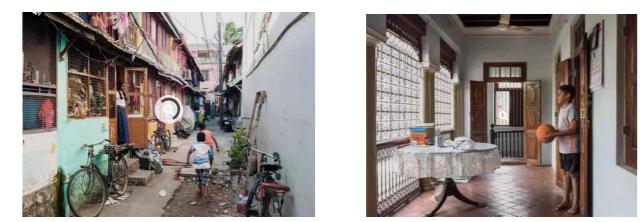
The streets of Chalai vividly inculcate the street vendors, shopkeepers and other hard-working classes, accentuating the versatility of the antique marketplace. The market is home to different castes, tribes and religions. They coexist congruously without any discrimination in racial classifications, age, gender, religion and philosophical discrepancies. Chalai market indoctrinates an overwhelming fable of tolerance, humility and universal love. In one of the corners of the Chalai bazaar, you will see old womenmakinggarlandsofjasmineandotherflowerssittingunder the dusky and golden sky. Flowers flaunt their colours and fragrances,captivatingthebuyerswho weave their way out of the streets. Chalai proudly presents one of the biggest flower markets in Keralaastherichscentsofblossomsbeckonthebuyersforaclosersniff.
Chalai bazaar is one of the most important places for the traditional as well as the contemporary cloth weaving culture of Kerala. It is considered to be the largest market hub in the city for
Figure
33
handlooms and cloth trading. The distinctive craftsmanship of the artisans empowers them to weaveadifferentstoryeachtimewiththeirhands.

The goldsmith and gold workers conquered the streets of Chalai centuries before. As you travel from Killipalam to Arysala, you will see numerous goldsmithsengagedintheirwork,obliviousto the noisy happenings on the streets. In the olden times, the goldsmiths used to blow the outer surface of burning gold with the help of a special instrument and manypersonsusedtosearchfor these sand particles and extract gold from these, in their struggle toearnsomemoneyforaliving.
The Chalai bazaar you will come across a wide range of simple, but most delicious lip smacking delicacies. There are restaurants that still maintain the traditional and authentic taste of the olden timessincedecadesandalsonewvarietiesoffood.
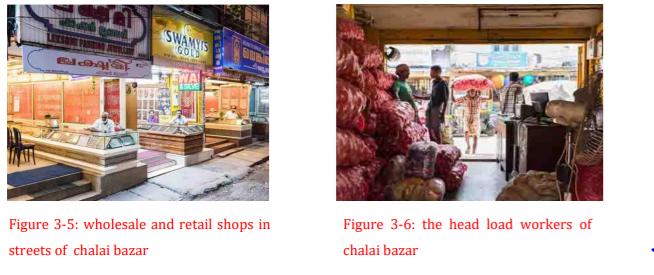 Figure3-4:goldsmithsandgoldworkersinstreetsofchalaibazar
Figure3-4:goldsmithsandgoldworkersinstreetsofchalaibazar
34
The native shops, open almost every day from morning to night, proffer all types of articles from vegetables to hardware, artefacts to handloom products, from fish to fresh vegetables. The jewelleries in Chalai offer a generous selection of ornaments made in various styles and patterns. They brilliantly exhibit a wide range of collections from meticulously crafted classical style to spoken novel designs. Next to these shops, you will find shoestoresjammedwithawiderangeof different types of shoes. Buyers wander from one shop to the other, heading out on a shopping spree
The old busy market was once the nerve centre of wholesale trade in Thiruvananthapuram. The market, laced with a number of wholesale shops, supply almost anything you can think of at affordable rates. The traders are honest and the items prove excellent value for money The bustling market areas provideawiderangeofhardwareandhomefurnishings,groceries,clothand shoe shops, vegetables, fruits, clothes, footwear, stationary, home appliances, flowers, vessels, items for the traditional poojas at home or in temples. It gives amiable shoppingopportunitiesfor thelocalsaswellasforthetourists.
Most commonly known as ‘Coolis’, the headload workers are considered to beoneofthebinding spirits in the trading history of the market. Though they are thought to be belligerentpeople,who demand inflated wages even for carrying small loads, we cannot disparage their efforts to earn a decent living. During the earlier times, they have been the most influential factors in the political and social hemispheres. Today, the trading community and the head load workers sustain a harmonious relationshipinthemarket.ItisimpossibletoimagineChalaibazaarwithoutthesevery significantgroupsofpersons,whotoildayandnighttokeepthemarketticking.
3.2.3 Balaramapuram (textile industry)
Balaramapuram, a town in the outskirts of Thiruvananthapuram, is home to Kerala‟s famous traditional weavers. This village once had more than 2,000 handloom workers, now it hosts little less than 500. Balaramapuram in Trivandrum district is one of the most historically important places for the handloom industry in Kerala. The wavers belong to the Chaliyar community who migrated from Nagarcoil and Thirunnelveli from present Tamil Nadu. They produce super fine 'Mundm Neriyathum' for the needs of the Travancore royal family. Weaving in Balaramapuram goesbacktotheeraofBalaramaVarma(1798to1810),ruleroferstwhileTravancore.HisDewan
Ummini Thampi settled seven weaver families of the Shalia community from Valliyoor, in Tirunelvelidistrict,inThiruvananthapuramtoweaveclothesfortheroyalfamily.Eventually,inthe memoryoftheruler,theplacecametobecalledBalaramapuram.
35
3.3 HandloomIndustryinKerala
Handloom Industry in Kerala took off during the 15th century when the British, French and Portuguese started trade with Kerala. They were impressed by the Kerala Kasavu, the traditional white and gold hand loommaterialandexportedthisinlargeamounts.Later,theGermansthrough "BaselMission"industrializedthissectorinnorthernKerala.
Today, the Handloom Sector is the second largest employment generator, after the coir industry. According to the 2009-2010 textile department report, 1.75 lakh people were employed by the industry.
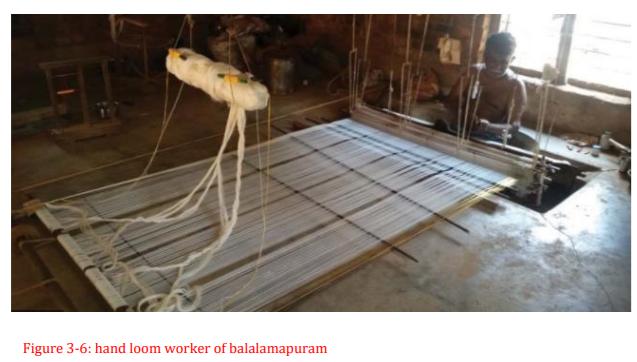
36
Table3-1:keraladistrictwisedistributionofhandloomworkers
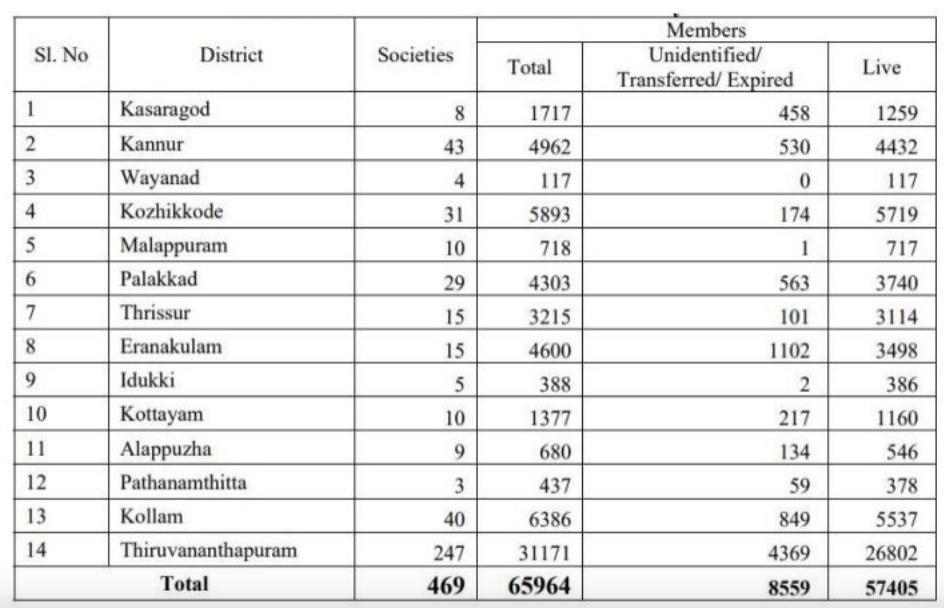
According to this tableweseethatThiruvananthapuramhasthemostnumberofweaverspresently employed while Wayanad has the least. Closely behind Thiruvananthapuram is Kollam and then Kannur
The reason for the presence of more weavers in Thiruvananthapuram is due to the popularity of co-operative weaving societies. These are government subsidized and hence any government textile project that is introduced is awarded to them. This ensures constant work flow for the weavers. The negative effect of such an initiative is the lack of such opportunities for individually practicing weavers. They must depend on small retailers to get raw materialsand market their products which have resulted in higher investmentandlowerreturns.
KeylocationoftheWeavingindustryhasbeenprominentin Map3-1:Keylocationofthe KeralasincetheI5thcentury.Mostoftheinitialweaving WeavingindustryinKerala

37
communities are weavers who migrated from Tamil Nadu to serve the Travancore royal family
ThemostimportantcentersareshowninMap3-1.
3.3.1 Weaver satisfaction rates
The weavers of Kerala are reluctant to stay in the industry due to the working conditions and wages. Survey of 2001-2002 showed Kannur and Kozhikode are the districts where the weavers are most paid withanaverageannualincomeofRs.9000.Thisisduetothefactorysystemthathas been set upbytheBasalMissionhere.TheweaversofThiruvananthapuramareunderpaid,withan average income of Rs.8000 despite the historical importance of the place and quality of the products.
Over the years this figure has reduced even more. The work places are unfit for female workers and even necessities such as toilets are not present. These issues have discouraged the new generationtotakeupjobsinthissector.
From the table, we can infer that the average wages of the weaversaresteadilydecliningoverthe years. In the year 2000 it was Rs.8736,butintheyear2002itdroppedtoRs.8252.Alsoaccording to the 2002 report, out of 21,000 weavers in Kerala 11,000 weavers were not satisfied witheither thewagesorthejobconditionswhereasonly3000weaversweresatisfiedwithboth.
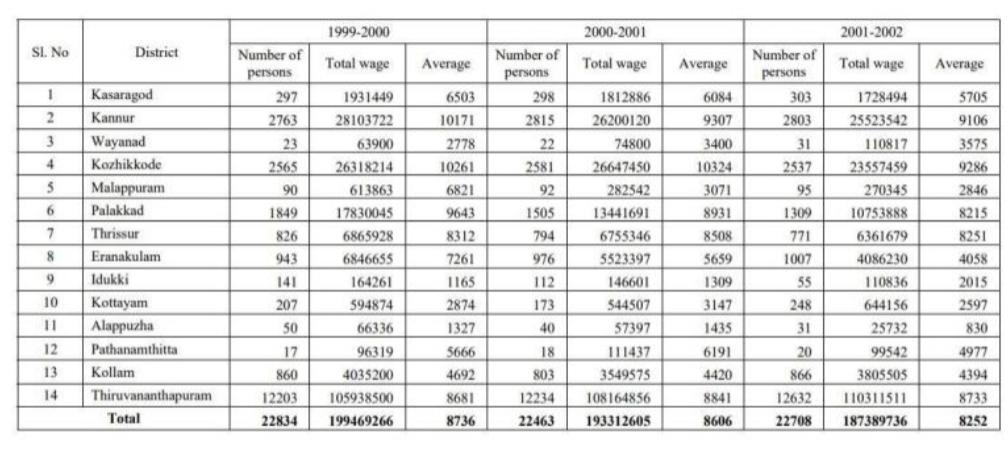 Table3-2:keraladistrictwiseWeaversatisfactionrates
Table3-2:keraladistrictwiseWeaversatisfactionrates
38
3.3.2 Present centers of the handloom industry in Trivandrum
The map indicates the locations of two different types of establishments in the district. The red dotsrepresentpositionsofcooperativesocietyandthepurpledotsspecifythedifferentgovernment offices. From this map, we can understand that most of the centers are established at different places in the district, thus proving fragmentation of the activities. Also, most of the co-operative societiesinthedistrictarenearBalaramapuramandincloseproximitytoChaliyarStreet.
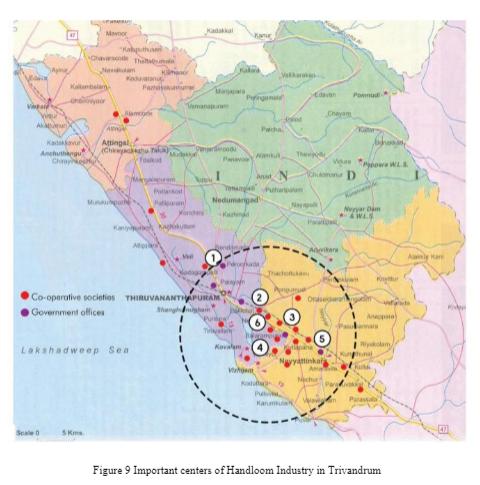
39
Map3-2:PresentcentersofthehandloomindustryinTrivandrum
4 Balaramapuraamtradesettlement
In this chapter deals with understanding the Balaramapuram trade settlement Balaramapuram textiletradesettlement
4.1.1 History of the cluster
A major handloom cluster, Balaramapuram is a small village in Thiruvananthapuram district of south Kerala,whichisfamousforfinecottonsareesanddressmaterials.TheBalarampuramsarees are well knownforitssimplicityandwornasatraditionalcostumebythewomenfolkofKerala.It is woven from un-dyed natural cotton thatcomplimentsthetropicalclimateofKerala.Itisusually a cream stretch of cloth with "Kasavu" (exquisite embroidery work created from silver wires coatedwithgold)borders.
The history of handloom weaving in Balaramapuram dates back to about 200 years ago and is associated with the royal family of Travancore (or Thiruvithamkur in Malayalam). The then princely state of Travancore with its capital at Thiruvananthapuram (also known as Trivandrum) comprised most of the southern parts of the present Kerala and the modern Nagarcoil and Kanyakumari districts of Tamil Nadu. The Dewan (the Chief Minister) of the then Maharaja, His Highness Maharaja Balarama Varma (from 1798 to 1810), Shri.UmminiThampiduringhisreign, brought weaving families from Valliyoor, in Tirunalveli District of the present Tamilnadu state. TheybelongedtotheShaliaorChaliacommunityandwerebroughttoweaveandsupplyclothesto the members of the royal family. The King allotted separate streets to them and gave financial assistance initially to start the business.(T.K. Velu Pillai, 1940; Nagam Aiya, 1906; Sreedhara Menon,1962;PattomG.Ramachandran,1996)
Subsequently, Maharaja Balarama Varma, on the advice of his Dewan, Shri. Ummini Thampi, converted Balaramapuram and its surrounding places into an agro-based industrial belt with various traditional industries such as handicrafts, handloom weaving, oil extraction, etc. Separate streets were formed at identified places with better infrastructure fordevelopment.Thelengthand width of these streets are well designed and constructed to facilitate warping and sizing in the street itself. Market places were also opened at convenient locations to market the products
CHAPTER4
40
conveniently It is due to theearnestandsincereeffortsmadebyHisHighnessMaharajaBalarama Varma by whose name the place Balaramapuram is presently known; the handloom weaving has becomepopularanddevelopedintoanimportantindustry
4.1.2 Structure of the se�lement
The uniqueness was thatthewidthandlengthofthewell-laidpathofthisstreetwassoconstructed to facilitate warping and sizing in the street itself. Today all communities live in these streets though now occupied mainly by Vaaniya, Mukkuva, Chetty, Muslim and Saliyas. Ezhava community has also now become an important part of weaving and other pre-loom activities though Muslims been initiated in Balaramapuramandsurroundingareasinthe19thcenturyitself.
Figure4-1:roughsketchofweaversstreetofBalaramapuram
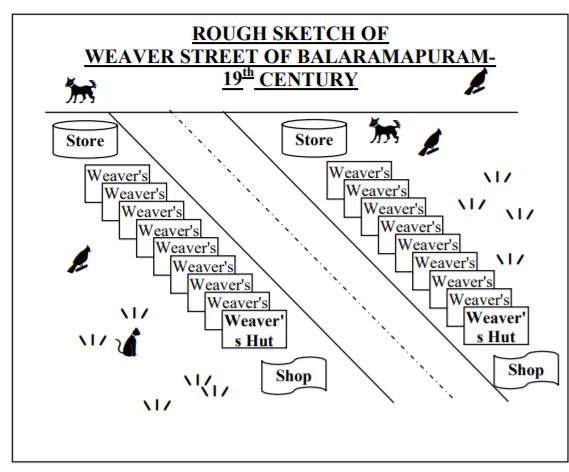
The town still sustains through these different communities. Due to the presence of many Tamil communities,thecultureoftheplaceisalsoamixtureofMalayalamandTamilcommunities.
● The Vaoiyar: They are traditional oil makers who migrated from Tamil Nadu. They own millsthatextractoiloutofdriedcoconut.
● The Muslims: The Muslims were brought and settled here for trade. They owned shopsin thecenteroftown.TheyarenativesofThakkalai,atownonKeralaTamilNaduborder
● The Mukkuvar: They are Christian communitieswhoareengagedinthefisheriesbusiness. They purchase fish from the fishermen in Kovalam and sell it at the town market in Balaramapuram.
41
● The Ezhaves: They were primarily farmers who owned small plots of land in theoutskirts ofthetownwheretheycultivatedcoconut,riceandtapioca.
● The Saliyas: Also known as Chaliyars, they are primarily the weaving community. They are traditionally Tamil speaking and engage in production and retail of traditional Kerala Handloommaterials
4.1.3 Present scenario
The weaving activity and the economic benefit derived out from theproductionandsaleofcotton handloom clothes in Balaramapuram based on the traditionalreputationwasnolongerconfinedto the members of the traditionalShaliacommunity ThehandloomindustryinBalaramapuramtoday provides jobs to thousands of families belonging to different castes and communitieslikeEzhava, Nadar, Nair, Mukkuva, and others, mostly belonging to the weaker sections of the society Today all communities live in these streets though now occupied mainly by Vaaniya, Mukkuva, Chetty, Muslimand12Saliyas.Ezhavacommunityhasalsonowbecomeanimportantpartofweavingand otherpre-loomactivitiesthoughMuslimsexclusivelydothesizing.
Thus the reputation of the name of Balaramapuram handloom products acquired by the Shalia community has now been enjoyed by a large number of people especially those belonging to economically and educationally backward sections. Balaramapuram handlooms have gained good
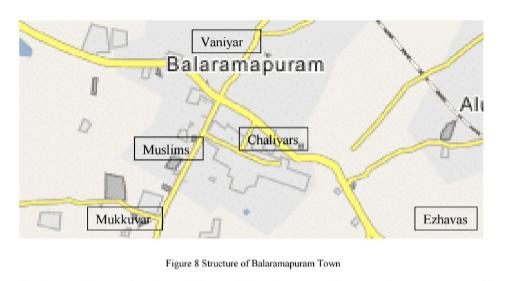
42
markets not only in Kerala and nearby States but are exported in limited quantities to the Middle EastcountriesalsowherelargenumbersofKeralitesareworking.
Presently there are 363 registered co-operative handloom societies, 21687 looms and 45598 registered weavers in Thiruvananthapuram District. Balaramapuram is the main hub of the handloomweavingandrelatedactivitiesinthedistrict.
43
CHAPTER5
5 Findings,conclusion,suggestions
This chapter deals with the findings, conclusions and suggestions based on the study of the Balaramapuramtradesettlement.
5.1 Findings
The Handloom sector plays a vital role in the economic development of a country Itisoneofthe largest economic activities after agriculture, providing direct employment to more than 43 lakhs weavers in Indiawith23.77lakhsHandlooms.Thissectorcontributesnearly15%ofthetotalcloth produced in the country and also contributes to the export earning Rs.3,000 Crores, 95% of the world Handloom fabric comes from India. Traditional Indian handloomenjoysaglobalreputation as well as huge demands in the local markets. However, the weavers face a number ofchallenges which affect their livelihood and overall wellbeing. The rapidly increasing industrialization, globalization and advent of modern technology have brought with various challenges for the developmentofthehandloomindustryespeciallytothetraditionalweavers.
The present study was an attempt to understand the problems and challenges faced by the traditional handloom weavers in the modernized textile industry. It also tries to shedlightintothe prospectsifanytheyhaveinthepresentscenario.
This studyisbasedonprimarydatacollectedthroughinterviewschedulesfromtraditionalweavers residing in Balaramapuram of Thiruvananthapuram District. The result of the study revealed that the weavers are facing a number of challenges like financial constraint, inability to purchase up-to-date machineries, poor working conditions, mere remuneration and the absence of government support which lead to the diminishing of the traditional trade settlement of Balaramapurm.
44
5.1.1 problems faced by the traditional handloom Weavers
The studyfoundthevariousproblemsfacedbythetraditionalhandloomWeavers.Thestudyfound that the Weavers faced problems likelow-income,issuesrelatedtotheirhealthetc.Majorityofthe Weavers are satisfied with their lives in terms of housing,basicneedsetcbuttheyonlyhavebasic facilities. The income from the weaving is not sufficient for their other needs like house maintenance, education of children and other secondary needs. The problems faced by the industriesinfluencetheWeavers'lifedirectlyorindirectly
The study found that the youngsters were hesitant to join the handloom industry, because of the straining nature of the job and its low income. The handloom industry is moving on to its destruction. Now the majority of the Weavers are middle aged people and they told that the youngsters are not entering into this field. It is due to various health issues like back pain, lung problem, body pain etc and also needs more effort than any other job. Theirworkingtimeisfrom 8amto6p.m.untilthistimetheyworkwithoutanyresttocompletetheirjob. Thedustfromtheloomcauseslungdiseases.
Some Weavers are weaving designer sarees in handlooms. Majority of weavers say that it is not difficult to weave designer sarees; but it requires more time. They get extra wages for weaving designer sarees. Due to a lack of technological upgradation the weavers face problems like time-consuming, health issues, stress etc. But the technological upgradation of looms lead to the destructionofhandlooms.Soitisnotpossibletomechanizetheloom.
The handloom is a part of our culture. The technological upgradation leads to extinction of that culture. Researcher is of opinion that the non implementation of new design techniques is one of the problems faced by the handloom industry. But it is not true that handloom weavers are very efficient to make new designs which attract the people to buy the handloom product. study finds out that the main problem faced by the industry is lack of employees. Many of the handloom industries were closed due to lack of employees. Weaving has nine steps. Each step requires employees.
But the hand loom industry is now facing difficulty in getting employees for various activities relatedtoweavingandthisindustryismovingtoitsextinction.Therearesome
45
schemes introduced by the government for the weavers' well being but the weavers say that they can't get anything from the government but they know about some schemes provided by the government.
5.1.2 SocioeconomicconditionsoftheWeavers
The handloom industry is one of the oldest cottage industries in India. The Weavers facing a number of challenges like low-income, absence of government support. The benefits of the governmentsupportdidnotreachthegrassrootspeople.
Majority of the weavers have their own house and it has basic facilitiesalso.Buttheincomefrom weaving is not sufficient to meet the needs like education for children, home maintenance, and infrastructurefacilities.
Majority of the Weavers have a primary level ofeducation.Aftercompletingtheirprimaryorhigh school level of education they are entering into handloom weaving in their earlyages.So,theydo not complete their education. But now they are not interested inbringingthisjobtotheirchildren. Theygavebettereducationtotheirchildren.
They are not interested in their children coming to this field. Because this field does not have sufficient income. They say that the prosperity of the handloom Industry is regenerated and their life also. MajorityoftheWeaversarefemales.Inthemajorityofthefamilythemalememberisthe mainsourceofincomealongwiththewomendoingweaving.
One of the positive things is that the Weavers get wages and bonus on correct time under the handloom units. They get bonuses on special occasions like Onam, Christmas etc. They get extra wagesforweavingdesignersarees.Inshort,theygetpaidontime.Butitisnotsufficient.
The study also found out that 30% of the total respondents are doing other jobs parallel to handloom like agriculture. The Weavers are mainly women and the men doing other jobs like construction work which have more income than weaving. Because of the low income the main factorswhichpullbacktheWeaversandrestrictyoungstersintothisfield.
5.1.3 Reasons for the downfall
● Lackofproperofinfrastructure
The present centres do not have sufficient infrastructure. This creates a bad work environment for the users, especiallywomen.Thisalsocauseshealthhazardssuchassight lossandbreathingtroubleincasesofweavers.
46
● Presenceofmiddlemenbetweenusersandmarket
The products sold used to be directly sold by the people in themarket.Butnowthereare manymenthatbuytheseproductsforaverylowratefromproducersandsellinthemarket forhigherrates.
● Lowwagesforthewearers
The weavers get paid or earn very less due to low demand for the product and industry
Therearemanygovernmentschemestryingtobetterthesituation
● Needforbettertechnology
The industry does not have any product development technique or production speeding technique research work going on .this slows down the industry and allows it to be engulfedbyglobalization
● Needforinnovativedesign
The products produced have not been upgraded since its introduction. The newer generation might find the collection of designs monotonous and boring So. Itisimportant tobringdesignersintothescenarioandimprovetheproductsofthehandloomindustry.
● LarkOnespeopleinthefield
There are fewerandfewerpeopletake;employmentinthisfieldduetoallthesementioned issues. Also, Youngsters tend to look forestablishedindustriestoworkin,Henceitisvery important to create an established centre for the industry. Scattering of the administrative infrastructure The industries have many different government and non-governmentbodies working to better thecases.Butthesearescatteredthroughoutthestateanddistrictmaking it difficult for the producers andtheorganizationstocollaborate.also,theproducersfindit difficulttodirectlyapproachsuchcentresforhelp.
47
5.2 CONCLUSION
Handloom sector is a major traditional industry.Butnowitisontheedgeofextinctionmainlydue to the invasion of power looms. The problem faced by the handloom industry affects the life of weavers. As a part of it the traditional Weavers also face problems and challenges. They faced varioussocio-economicandphysicalproblemsandchallenges.
The Weavers get wages and bonuses on time but it is not sufficient to maintain the economic balance. So they seek other jobs parallel to it. Majority of the members are women in this study who are engaged in weaving.Andthemalemembersinthefamilydonotonlyinvolveinweaving, theyalsogotootherjobswhichhavemoreincome.
So, this study reveals that the majorityofthefamilyarenotonlydependingonthehandloom.But a small proportion of people are still completely dependentonhandlooms.Thehandloomindustry is now on the edge of its decline. But in the market the handloom product still has the highest demand. Due to the lack of sufficient income the Weavers and the youngsters are hesitant to join this industry thus so many handloom units were closed so, there is no sufficient production processingevenifthedemandishigh.
Another challenge faced by this industry is the invasion of power loom products in the name of Balaramapuram kaithari. In this case the customers are not able to identify the real handloom product.Thesellersalsoencouragethepowerloomproduct.Soitisthemainproblemaffectingthe Industry From the present study it is concluded that Handloom weavers in Balaramapuram are mostly traditional weavers and they are in a pitiable condition, owing to poor socio-economic conditions. However various unfavourable factors lead to decline on theaspectofsocio-economic conditions.Majorityofthemarewageweaversworkingformorethan8hours.
The integration of all the different activities thus reducing fragmentation and creating opportunities for research and testing can bring the lost glory to the industry. This will in turn help the industry apply more technologies and new age designs into the productionprocess.Theultimategoalistohelptheindustrysurviveinthefast-changingworld.
Hencetheworkhomestypologiescanbeusedinrevitalizationofthetraditionalsettlementasithas link towards the past and also helps in formation of a specifiedidentifiablesetoftplaceoftrade by integrating the activities in the settlement using the elements , typologies and modernideasof workhomesforeconomicgrowthandrevitalisationofthetradesettlementofBalaramapuram.
48
BIBLIOGRAPHY
Work home. Retrieved from https://en.wiktionary.org
What is a work home?.Retrievedfromhttp://www.theworkhome.com
Work home history .Retrievedfromhttp://www.theworkhome.com
Holliss,F.(2019).the workhome: an architecture of dual-use. Retrievedfrom.
https://www.researchgate.net/publication/340127617_THE WORKHOME AN ARCHITECT URE OF DUAL-USE
Holliss,F.(2008). From Longhouse to Live/work Unit: Parallel histories and absent narratives.Retrieved from.
https://www researchgate net/publication/270341227 From Longhouse to Livework Unit Parallel histories and absent narratives
Dolan, T (2012) Live-work planning and design: zero-commute housing Hoboken: John Wiley & Sons
Ganesuni.s.c. (2018). Work-Homes. Retrieved from. https://lib.dr.iastate.edu/etd/16354
Holliss, F. (2008). Beyond Live / Work. Retrieved from.
https://www.researchgate.net/publication/270341198 Beyond Livework
Vargees.Aandsalim.H.Handloom industry in kerala: a study of the problems and challenge.Retrieved from.
https://www.researchgate.net/publication/281748233_HANDLOOM_INDUSTRY_IN_KERAL A_A_STUDY_OF_THE_PROBLEMS_AND_CHALLENGES
"Anchuthengu and Anjengo Fort, Varkala, Thiruvananthapuram, Kerala, India | Kerala Tourism".Retrievedfrom.www.keralatourism.org
Neha.N(2019).Integrated Handloom Center Thiruvananthapuram.Retrievedfrom.
https://issuu.com/nehanowshath/docs/n.neha_-thesis_report
49
“Two-Century Old Stories of Chalai Bazaar — The Major Commodity Market of Thiruvananthapuram City”.Retrievedfrom.http://mywordsnthoughts.com/myworld/all-aboutkerala/two-century-old-stories-of-chalai-bazaar-the-major-commodity-market-ofthiruvananthapuram-city
50












 Figure2-2:livewithintypology
Figure2-3:workhometypologybasedonmovement
2.5.2.2 Mobileworkhomes
2.5.2.3 Immobileworkhomes
Figure2-2:livewithintypology
Figure2-3:workhometypologybasedonmovement
2.5.2.2 Mobileworkhomes
2.5.2.3 Immobileworkhomes


 Figure2-5:live-nearbytypology
Figure2-5:live-nearbytypology

 Figure2-7:Relationshipbetweentypologiesofworkhomes
Figure2-7:Relationshipbetweentypologiesofworkhomes
 Figure
Figure


 Figure3-2:chalaibazaar,Trivandrum
Figure3-2:chalaibazaar,Trivandrum


 Figure3-4:goldsmithsandgoldworkersinstreetsofchalaibazar
Figure3-4:goldsmithsandgoldworkersinstreetsofchalaibazar



 Table3-2:keraladistrictwiseWeaversatisfactionrates
Table3-2:keraladistrictwiseWeaversatisfactionrates


